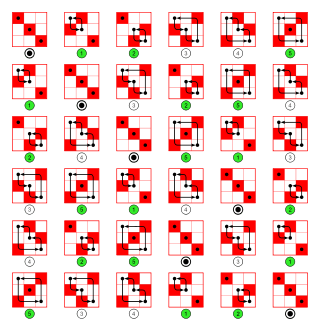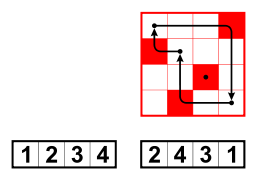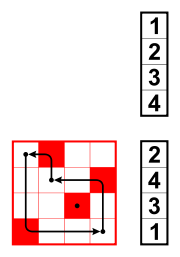Permutation matrix

The product of two permutation matrices is a permutation matrix as well.
These are the positions of the six matrices:

(They are also permutation matrices.)
In mathematics, in matrix theory, a permutation matrix is a square binary matrix that has exactly one entry of 1 in each row and each column and 0s elsewhere. Each such matrix represents a specific permutation of m elements and, when used to multiply another matrix, can produce that permutation in the rows or columns of the other matrix.
Definition
Given a permutation π of m elements,
given in two-line form by
its permutation matrix acting on m-dimensional column vectors is the m × m matrix Pπ whose entries are all 0 except that in row i, the entry π(i) equals 1. We may write
where denotes a row vector of length m with 1 in the jth position and 0 in every other position.[1]
Properties
Given two permutations π and σ of m elements, the corresponding permutation matrices Pπ and Pσ which act on column vectors can be composed
However, note that if the corresponding permutation matrices are defined to act on row vectors, i.e., where is the Kronecker delta, the rule is reversed
As permutation matrices are orthogonal matrices (i.e., ), the inverse matrix exists and can be written as
Multiplying times a column vector g will permute the rows of the vector:
Multiplying a row vector h times will permute the columns of the vector by the inverse of :
Again it can be checked that .
Notes
Let Sn denote the symmetric group, or group of permutations, on {1,2,...,n}. Since there are n! permutations, there are n! permutation matrices. By the formulas above, the n × n permutation matrices form a group under matrix multiplication with the identity matrix as the identity element.
If (1) denotes the identity permutation, then P(1) is the identity matrix.
One can view the permutation matrix of a permutation σ as the permutation σ of the rows of the identity matrix I, or as the permutation σ−1 of the columns of I.
A permutation matrix is a doubly stochastic matrix. The Birkhoff–von Neumann theorem says that every doubly stochastic real matrix is a convex combination of permutation matrices of the same order and the permutation matrices are precisely the extreme points of the set of doubly stochastic matrices. That is, the Birkhoff polytope, the set of doubly stochastic matrices, is the convex hull of the set of permutation matrices.[2]
The product PM, premultiplying a matrix M by a permutation matrix P, permutes the rows of M; row i moves to row π(i). Likewise, MP permutes the columns of M.
The map Sn → A ⊂ GL(n, Z2) is a faithful representation. Thus, |A| = n!.
The trace of a permutation matrix is the number of fixed points of the permutation. If the permutation has fixed points, so it can be written in cycle form as π = (a1)(a2)...(ak)σ where σ has no fixed points, then ea1,ea2,...,eak are eigenvectors of the permutation matrix.
To calculate the eigenvalues of a permutation matrix , write as a product of cycles, say, . Let the corresponding lengths of these cycles be , and let be the set of complex solutions of . The union of all s is the set of eigenvalues of the corresponding permutation matrix. The geometric multiplicity of each eigenvalue equals the number of s that contain it.[3]
From group theory we know that any permutation may be written as a product of transpositions. Therefore, any permutation matrix P factors as a product of row-interchanging elementary matrices, each having determinant −1. Thus the determinant of a permutation matrix P is just the signature of the corresponding permutation.
Examples
Permutation of rows and columns
When a permutation matrix P is multiplied with a matrix M from the left (PM) it will permute the rows of M (here the elements of a column vector),
when P is multiplied with M from the right (MP) it will permute the columns of M (here the elements of a row vector):
 P * (1,2,3,4)T = (4,1,3,2)T |
 (1,2,3,4) * P = (2,4,3,1) |
Permutations of rows and columns are for example reflections (see below) and cyclic permutations (see cyclic permutation matrix).
| reflections | ||
|---|---|---|
These arrangements of matrices are reflections of those directly above. |
Permutation of rows
The permutation matrix Pπ corresponding to the permutation : is
Given a vector g,
Explanation
A permutation matrix will always be in the form
where eai represents the ith basis vector (as a row) for Rj, and where
is the permutation form of the permutation matrix.
Now, in performing matrix multiplication, one essentially forms the dot product of each row of the first matrix with each column of the second. In this instance, we will be forming the dot product of each row of this matrix with the vector of elements we want to permute. That is, for example, v= (g0,...,g5)T,
- eai·v=gai
So, the product of the permutation matrix with the vector v above, will be a vector in the form (ga1, ga2, ..., gaj), and that this then is a permutation of v since we have said that the permutation form is
So, permutation matrices do indeed permute the order of elements in vectors multiplied with them.
See also
References
- Brualdi, Richard A. (2006). Combinatorial matrix classes. Encyclopedia of Mathematics and Its Applications. 108. Cambridge: Cambridge University Press. ISBN 0-521-86565-4. Zbl 1106.05001.
- Joseph, Najnudel; Ashkan, Nikeghbali (2010), The Distribution of Eigenvalues of Randomized Permutation Matrices (PDF)

